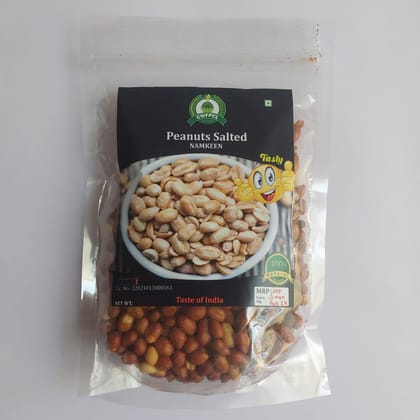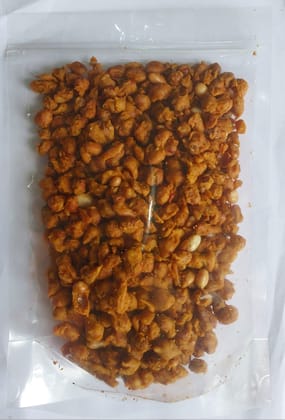Cheenabadam Women farmer Producer Company Limited
Groundnut
500 gram
₹100
MRP ₹130
| Country of origin | India |
|---|---|
| Brand | Cheenabadam Women farmer Producer Company Limited |
| Net Quantity | 500 gram |
| Additive info | Groundnuts, or peanuts, can be processed and sold in various forms, and sometimes additives are used to enhance flavor, preserve freshness, or improve texture. Here's information on common additives and treatments for groundnuts: Common Additives in Groundnuts: Salt: Purpose: Enhances flavor. Commonly Found In: Salted peanuts, peanut butter, and roasted peanut snacks. Sugar: Purpose: Adds sweetness. Commonly Found In: Honey-roasted peanuts, sweetened peanut butter, and candy-coated peanuts. Oil: Purpose: Used for roasting and enhancing flavor. Commonly Found In: Roasted peanuts (especially in-oil roasted varieties). Preservatives: Purpose: Extends shelf life and prevents spoilage. Examples: BHT (Butylated Hydroxytoluene), BHA (Butylated Hydroxy anisole). Commonly Found In: Packaged peanuts, peanut butter. Flavorings: Purpose: Adds specific tastes like honey, barbecue, or spicy flavors. Examples: Natural and artificial flavors, spices. Commonly Found In: Flavored peanut snacks. Stabilizers: Purpose: Prevents oil separation in peanut butter. Examples: Hydrogenated vegetable oils. Commonly Found In: Commercial peanut butter. Emulsifiers: Purpose: Ensures consistent texture and prevents separation. Examples: Lecithin. Commonly Found In: Peanut butter and some processed peanut products. Processing Methods Affecting Additives: Roasting: Peanuts are often roasted to enhance flavor, which can involve dry roasting or oil roasting. Additives like salt and oil are commonly used in this process. Blanching: Removing the skin from peanuts involves treating them with heat, which might include using steam or water. No additives are typically introduced in this process. Flavor Coating: Peanuts can be coated with various flavorings and spices, which may involve adding multiple ingredients like salt, sugar, artificial flavors, and coloring agents. Grinding for Peanut Butter: The grinding process to make peanut butter often involves adding stabilizers, salt, and sometimes sugar or other sweeteners to achieve the desired taste and consistency. Label Reading: When buying processed peanut products, it’s essential to read the labels to understand the additives included. Labels will list all ingredients, including any added salt, sugar, preservatives, and flavorings. Look for products with fewer additives for a more natural choice. Considerations for Allergies and Dietary Restrictions: Allergens: Groundnuts are a common allergen. Individuals with peanut allergies should avoid all peanut products and be cautious about cross-contamination. Dietary Preferences: For those seeking organic or natural products, look for groundnuts and peanut products labeled as such, which often have fewer additives and preservatives. Understanding the additives and processing methods helps consumers make informed choices based on their dietary needs and preferences. |
| Expiry Date | 5 month |
| Food type | veg |
| Nutritional information | Groundnuts, or peanuts, have a rich nutritional profile, making them a valuable food source. Here is the approximate nutritional value for 100 grams of raw peanuts: Nutritional Value per 100 Grams: Calories: 567 kcal Protein: 25.8 grams Total Fat: 49.2 grams Saturated Fat: 6.28 grams Monounsaturated Fat: 24.43 grams Polyunsaturated Fat: 15.56 grams Carbohydrates: 16.1 grams Dietary Fiber: 8.5 grams Sugars: 4.7 grams Vitamins: Vitamin E: 8.33 mg (55% of the Daily Value, DV) Niacin (B3): 12.07 mg (60% of the DV) Folate (B9): 240 µg (60% of the DV) Thiamine (B1): 0.64 mg (43% of the DV) Vitamin B6: 0.35 mg (18% of the DV) Minerals: Magnesium: 168 mg (42% of the DV) Phosphorus: 376 mg (38% of the DV) Potassium: 705 mg (20% of the DV) Zinc: 3.27 mg (30% of the DV) Iron: 4.58 mg (25% of the DV) Calcium: 92 mg (9% of the DV) Selenium: 7.2 µg (10% of the DV) Health Benefits: High Protein Content: Essential for muscle repair and growth. Healthy Fats: Rich in monounsaturated and polyunsaturated fats, which are beneficial for heart health. Fiber-Rich: Aids in digestion and helps maintain a healthy digestive system. Antioxidants: Contains vitamin E and other compounds that have antioxidant properties, helping to protect cells from damage. Micronutrients: Provides essential vitamins and minerals that support various bodily functions, including metabolic processes and immune function. Groundnuts are versatile and can be included in various diets, contributing to overall health and well-being. |
| Instructions | Groundnuts can be prepared and used in a variety of ways, from simple snacks to ingredients in complex dishes. Here are instructions for different methods of preparing and using groundnuts: 1. Roasting Groundnuts Dry Roasting: Ingredients: Raw groundnuts (peanuts) Optional: Salt Instructions: Preheat your oven to 350°F (175°C). Spread the raw groundnuts in a single layer on a baking sheet. Place the baking sheet in the oven and roast for 20-25 minutes, stirring occasionally to ensure even roasting. Check for doneness: the groundnuts should be golden brown and give off a nutty aroma. Remove from the oven and let cool. If desired, sprinkle with salt while still warm. Oil Roasting: Ingredients: Raw groundnuts (peanuts) Cooking oil (such as peanut oil) Optional: Salt Instructions: Heat oil in a deep pan or fryer to 350°F (175°C). Add raw groundnuts to the hot oil, ensuring they are fully submerged. Fry for 3-5 minutes, stirring occasionally to prevent burning. Remove groundnuts using a slotted spoon and drain on paper towels. Sprinkle with salt if desired and let cool. 2. Making Peanut Butter Ingredients: 2 cups roasted groundnuts (peanuts) Optional: Salt, honey, or oil (for creamier texture) Instructions: Place the roasted groundnuts in a food processor. Blend on high until the peanuts are broken down into a thick, creamy consistency. This may take several minutes. For a smoother texture, add a small amount of oil (such as peanut oil) and continue blending. Taste and add salt or honey if desired, then blend again to incorporate. Transfer the peanut butter to a jar and store in the refrigerator. 3. Boiling Groundnuts Ingredients: Raw groundnuts (peanuts) in shells Water Salt Instructions: Rinse the groundnuts thoroughly to remove any dirt. Place the groundnuts in a large pot and cover with water. Add salt (about 1 cup per gallon of water) and stir to dissolve. Bring the water to a boil, then reduce to a simmer. Cook for 2-3 hours, or until the peanuts are tender. You may need to add more water during cooking to keep the peanuts submerged. Drain and let cool before serving. 4. Using Groundnuts in Cooking Groundnut Soup (Peanut Soup): Ingredients: 1 cup groundnut paste (or peanut butter) 1 onion, chopped 2 tomatoes, chopped 1 bell pepper, chopped 4 cups vegetable or chicken broth Salt and pepper to taste Optional: Spices (such as cumin, garlic, or ginger) Instructions: In a large pot, sauté the onion until soft. Add the tomatoes and bell pepper and cook until tender. Stir in the groundnut paste and mix well. Gradually add the broth, stirring constantly to avoid lumps. Bring to a boil, then reduce heat and simmer for 20-30 minutes. Season with salt, pepper, and any additional spices. Serve hot, garnished with fresh herbs if desired. Groundnut Sauce: Ingredients: 1 cup groundnut paste (or peanut butter) 1 cup coconut milk or water 1-2 tablespoons soy sauce 1 tablespoon lime juice 1-2 teaspoons sugar or honey Optional: Chili flakes or hot sauce for spice Instructions: In a saucepan, combine the groundnut paste and coconut milk (or water). Cook over medium heat, stirring constantly until the mixture is smooth. Add soy sauce, lime juice, and sugar. Mix well. Simmer for 5-10 minutes, stirring occasionally. Adjust seasoning to taste, adding chili flakes or hot sauce if desired. Serve as a dipping sauce or over grilled meats, vegetables, or rice. These instructions provide a variety of ways to enjoy groundnuts, whether as a snack, a spread, or a key ingredient in a meal. |
| contact details consumer care | Cheenabadam Women Farmer Producer Company Limited, [email protected], +917847926659 |

Sold By
Cheenabadam Women Farmer Producer Company Limited
Not Cancellable
Not Returnable




















